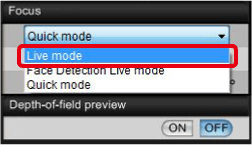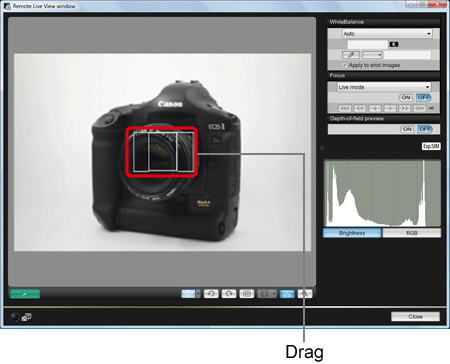Using EOS Utility to Change the AF Mode and Use the Remote Live View Function to Shoot Still Photos and Movies Remotely (EOS REBEL T1i/EOS 500D)
13-Apr-2009
8200518300
Solution
You can operate your camera remotely from EOS Utility and shoot still photos while looking at the subject on the EOS Utility screen. Also, the captured image is directly saved on your computer; therefore, you can check it with Digital Photo Professional.
IMPORTANT
You cannot operate the camera when the [Remote Live View window] is displayed. When you press the <  > (Live View Shoot) button, the Live View image will also display on the camera's LCD monitor, allowing you to view the image while operating the camera.
> (Live View Shoot) button, the Live View image will also display on the camera's LCD monitor, allowing you to view the image while operating the camera.
 > (Live View Shoot) button, the Live View image will also display on the camera's LCD monitor, allowing you to view the image while operating the camera.
> (Live View Shoot) button, the Live View image will also display on the camera's LCD monitor, allowing you to view the image while operating the camera. 1. Turn the camera's power switch to <ON>.
- This camera cannot communicate with EOS Utility if the camera's mode dial is set to <
 >.
>. - Set the mode dial to a mode other than <
 >.
>.
2. Once EOS Utility starts, click [Camera settings/Remote shooting].

3. The capture window appears, so set the settings items for shooting.

4. To shoot movies, set the camera's mode dial to <  >. To shoot still photos, set the camera's mode dial to a mode other than <
>. To shoot still photos, set the camera's mode dial to a mode other than <  >.
>.
 >. To shoot still photos, set the camera's mode dial to a mode other than <
>. To shoot still photos, set the camera's mode dial to a mode other than <  >.
>.5. Set the Live View function.
5-1. Click  to display the [Set-up menu], and then click [Live View/Movie func. set.](
to display the [Set-up menu], and then click [Live View/Movie func. set.](  ).
).
 to display the [Set-up menu], and then click [Live View/Movie func. set.](
to display the [Set-up menu], and then click [Live View/Movie func. set.](  ).
). 5-2. The [Live View/Movie func. set.] window appears, so select [Enable] in the LV func. setting to shoot still photos, and select a movie recording size in Movie rec. size to shoot movies, and then click [OK](  ).
).
 ).
).
6. Click the [Remote Live View shooting] button.

7. The [Remote Live View window] appears, so check the shooting image.

8. If you want to focus using AF (autofocus), set the lens focus mode switch to <AF>.

9. Because the mouse cursor will change in shape as follows if it is moved to the inside of the rectangular frame on the screen, drag the enlargement display frame to move it to the position where you want to focus.

10. Click [  ] in the lower center of the window to display the enlarged image.
] in the lower center of the window to display the enlarged image.
 ] in the lower center of the window to display the enlarged image.
] in the lower center of the window to display the enlarged image. The section you selected in step 9 is displayed enlarged at 100% (actual pixel size)

To move the display position in the [Zoom View] window, click either [  ], [
], [  ], [
], [  ], or [
], or [  ].
].
 ], [
], [  ], [
], [  ], or [
], or [  ].
]. Double-click an image in the [Zoom View] window to return to the [Remote Live View window].
Next, adjust the focus of the camera in EOS Utility. You can focus the camera manually or automatically (AF). Please proceed to Part II 1, 2, 3, or 4 depending on the method of focusing.
Part II 1, 2, 3, and 4 describe common procedures for shooting still photos and movies.
You can focus manually while viewing the enlarged image in the Remote Live View window.
11. Once you have proceeded up to Step 10 of Part I, Click the [Focus] buttons to bring the image into focus.
The [Remote Live View window] changes in real time according to the focus position adjustment.

Focusing Adjustment Amount
-
 ,
,  : Adjustment amount: Large
: Adjustment amount: Large -
 ,
,  : Adjustment amount: Medium
: Adjustment amount: Medium -
 ,
,  : Adjustment amount: Small
: Adjustment amount: Small
Please proceed to Part III.
In Live AF mode, images can be focused automatically in the same way as on the camera itself.
11. Once you have proceeded up to Step 10 of Part I, Select [Live mode] from the [Focus] list box.
The AF points appear.

12. Drag the enlargement display frame to move it to the position where you want to focus.

13. Click [ON].
- AF is executed.
- When focus is achieved, the camera makes a beeping sound, image will reappear in the Remote Live View window and the AF point turns green.
- If focus is not achieved, the AF point turns red.

Please proceed to Part III.
In  (Face detection) Live AF mode, images can be focused automatically in the same way as with the camera itself.
(Face detection) Live AF mode, images can be focused automatically in the same way as with the camera itself.
 (Face detection) Live AF mode, images can be focused automatically in the same way as with the camera itself.
(Face detection) Live AF mode, images can be focused automatically in the same way as with the camera itself.11. Once you have proceeded up to Step 10 of Part I, Select [Face Detection Live mode] from the [Focus] list box.
- When a face is detected, an AF point appears.
- When there is a face other than the face detected by the camera, a new AF point appears when you move the cursor to the position of the other face. Clicking that position selects the AF point.

12. Click the [ON] button.
- AF is executed.
- When focus is achieved, the camera makes a beeping sound and the AF point turns green.
- If focus is not achieved, the AF point will turn red.
- If a face cannot be detected, the AF point will be fixed to the center for focusing.

Please proceed to Part III.
In Quick AF mode, images can be focused automatically in the same way as on the camera itself.
11. Once you have proceeded up to Step 10 of Part I, Select [Quick mode] from the [Focus] list box.
The AF points appear.

12. Click the AF point in the position where you want to focus.
- You can switch between automatic AF point selection and manual AF point selection by clicking the [
 ] in the [
] in the [  ].
]. - In automatic selection, all the AF points are automatically selected.

13. Click [ON].
- AF is executed.
- When focus is achieved, the camera makes a beeping sound, image will reappear in the Remote Live View window and the AF point turns green.
- To cancel AF operation, click [OFF].

Please proceed to Part III.
When focus is achieved and the camera is ready for shooting, start shooting.
Still photos : Click the camera release button to shoot. The captured images are transferred to the computer, Digital Photo Professional starts automatically, and the captured images are displayed.
Movies : Click the [  ] button at the bottom left of the [Remote Live View window]. and then click the [
] button at the bottom left of the [Remote Live View window]. and then click the [  ] button and begin shooting. To end shooting, click the [
] button and begin shooting. To end shooting, click the [  ] button again.
] button again.
 ] button at the bottom left of the [Remote Live View window]. and then click the [
] button at the bottom left of the [Remote Live View window]. and then click the [  ] button and begin shooting. To end shooting, click the [
] button and begin shooting. To end shooting, click the [  ] button again.
] button again.
NOTE
Images shot in Live View Mode can be recorded both on a PC and a memory card.
To perform this setting, click [Preferences] in the main window of EOS Utility to display the [Preferences] dialog box, click the <Remote Shooting> tab, and then in the window that appears, select the [Save also on the camera's memory card] checkbox.
Explanations for the Remote Live View operation method are complete.